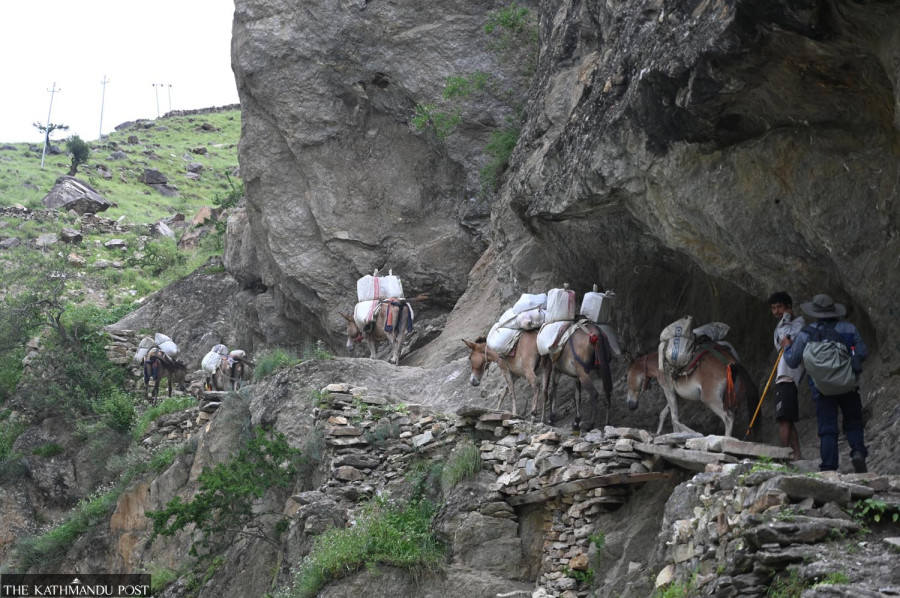National
Nepal, China to issue five-year passes for Himalayan districts
Residents of 15 districts who rely on Tibet for trade and daily needs will benefit from the new arrangement.
Anil Giri
Nepal and China have agreed to issue five-year entry and exit passes for people in 15 districts of northern Nepal abutting China. After incorporating Chinese feedback, the Department of Immigration, under the the Ministry of Home Affairs, has recently redesigned the entry/exit pass and come with an operating procedure, which was first approved on June 19 by the ministry.
The new arrangement, which is in line with the bilateral agreement and immigration regulations, will allow Nepali citizens living near the Chinese border to enter and exit from China’s Autonomous Region, Tibet, states one of the objectives of the operating procedure issued by the government.
Nepali citizens living in northern districts who depend on Tibet for trade, pilgrimage, work, health checks and other daily activities, have long been complaining of hassles in visiting Tibet due to lack of mandatory passes.
However, this arrangement was suspended after the onset of Covid pandemic at the end of 2019. And after China started reopening 14 traditional entry points, some local units on the Nepali side started issuing temporary “China Departure and Entry Permits” locally. Now, to streamline the entry and exit permission, the Department of Immigration is all set to issue digital passes to residents of the 15 districts. However, Nepali citizens from other districts will need a visa to enter Chinese territory.
According to the operating procedure, the 15 districts where the passes would be distributed are Taplejung, Sankhuwasabha, Solukumbhu, Dolakha, Sindhupalchok, Rasuwa, Dhading, Gorkha, Manang, Mustang, Dolpa, Mugu, Humla, Bajhang and Darchula.
Those 14 dedicated trading/entry/exit points between Nepal and China are Tiptala (Taplejung); Kimathnaka (Sankhuwasabha); Falak and Lapchi of Dolakha; Tatopani and Gumba of Sindhupalchok; Lazing and Chhekampar (Gorkha); Korala of Mustang; Hilsa (Humla); Nakcha (Mugu); Maringla Bhanjyang (Dolpa); Urai (Bajhang); and Tinkar of Darchula district.
According to the Department of Immigration, the entry pass will, however, not be issued immediately in Solukumbhu, Dhading, and Manang districts due to ongoing adverse weather conditions.
“A decision has already been made to issue digital passes. It is in the implementation process,” said Koshahari Niraula, Director General at the Department of Immigration. “Necessary instructions have been given to the immigration and district administration offices for implementation.”
Before 2007, Nepali and Chinese nationals from border districts could travel up to 30 kilometres inside each other’s territory without restrictions. However, in January 2007, both sides reached a new agreement under which an identity card with one year validity was made mandatory, said noted cartographer Buddhi Narayan Shrestha. Now, both sides have developed a digital identity card.
Nepal and China first entered an ‘Agreement on Trade and other Related Matters between the Tibetan Autonomous Region (TAR) of China and Nepal’ on September 30, 1956, which was last renewed on July 10, 2002.
The agreement says those wishing to travel to the other country must hold valid passports issued by the sending country and a visa issued by the receiving country. Inhabitants of the border districts shall hold exit-entry passes with photo-affixed ID cards for border trade, pilgrimage and to visit relatives and friends, according to the agreement.
Shrestha said those with the entry/exit passes are not allowed to travel beyond the border districts into the interior of the other country.
“Generally, the limit is 30 km from the borderline. And those with permits for pilgrimage can travel through the designated routes and allotted entry points. They are not permitted to stay in the border districts of the receiving country for more than a month. Either party has the right to refuse entry into its territory of anyone deemed persona non-grata,” according to Shrestha.
A senior foreign ministry official confided to the Post that the Chinese side initially expressed some reservations about the proposed operating procedure, particularly the issuance of five-year passes to Nepali citizens in the 15 northern districts. They had also called for making the passes digital.
After considering the Chinese request, the foreign ministry official said that the home ministry had redesigned the new pass, revisiting some conditions that were initially proposed.
Niraula said the Chinese side has agreed to issue the pass for five years. “With their consent, we have finalised and issued the new operating procedure.”
According to one Home Ministry official, the ministry and the Department of Immigration agreed to incorporate biometric security features into the pass, as requested by Chinese officials. The new pass with biometric information is intended to curb illegal and criminal activities across the Nepal-Tibet border.
The five-year pass will be issued exclusively to Nepali citizens living in the 15 border districts, their siblings, and those who are married and living permanently in these districts.
Also, those who have migrated from other districts and are now permanently living in these 15 districts are eligible for the pass.
However, if someone gets married and migrates to another district, they will not get the pass.
To obtain the entry pass, one should fill out a form and provide required documents including a copy of the citizenship, a recommendation letter from the ward office, a migration letter if the service seeker has migrated from another district, a marriage certificate (for those coming from another district after marriage) and a passport-sized photo, according to the operating procedure.
After verifying all the documents and information, the immigration office issues the permit, said the work plan. In case a district does not have immigration office, the service seekers should visit the district administration offices to receive the pass.
“The permit is not transferable and will remain valid for up to five years from the date of issuance. Once it expires, one should reapply. If the card is lost or destroyed, the same process should be followed to get a copy of the permit,” according to the operating procedure.
Madav Sapkota, a CPN (Maoist Centre) lawmaker from Sindhupalchok district, lauded the development and said it will benefit the people living in bordering districts.
“The process was started when Pushpa Kamal Dahal was the prime minister, and now it is set to be formalised. Earlier, the Chinese authorities would issue one-year entry permits, and after Covid, they limited it to a day-long pass. If the entry process is simplified further, it will benefit the citizens from both sides even more,” said Sapkota.




 6.73°C Kathmandu
6.73°C Kathmandu










%20(1).jpg&w=300&height=200)




